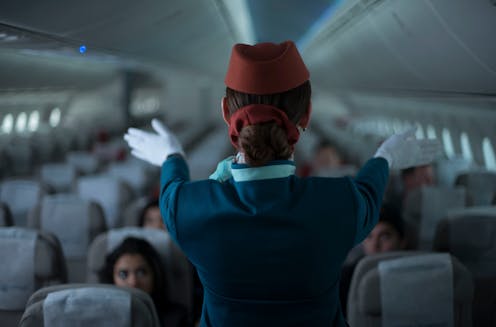flight attendants on being unwilling stars of viral videos
- Written by Liz Simmons, PhD Candidate, Griffith University

As any frequent social media user knows, airline passengers often record and post in-flight incidents – from frightening turbulence to unruly members of the public.
Often, these viral videos feature flight attendants just trying to do their duties, while being filmed without their consent.
These videos usually portray flight attendants either as heroes effortlessly managing difficult passengers or “villains” accused of being rude and unprofessional. Either way, the trend is emerging as an industrial issue, with unions arcing up about it and airlines bringing in new rules aimed at curbing the practice.
Read more: Qantas won't like it, but Australian travellers could be about to get a better deal on flights[1]
Unkind comments about appearance and age
Going to work knowing that at any moment you may become the unwilling star of a viral video can exact a considerable toll on the wellbeing of flight attendants.
I (Liz Simmons) speak daily with flight attendants in Australia and abroad as part of my PhD research. From these discussions, I’ve heard from attendants who worry often about discovering videos of themselves featuring unkind comments about their appearance, age or employer.
One flight attendant, Kate*, described the disconcerting feeling of someone aiming a smartphone camera at her while she was simply trying to do her job, saying:
You don’t know why they’re filming or what they’ll do with it.
Marie spoke of being featured in a TikTok video during a safety demonstration, with viewers making fun of her appearance.
Charlotte, after refusing to serve more alcohol to an intoxicated passenger, had a camera thrust in her face, accompanied by threats to her job.
Mark told of how uncomfortable he felt having to ask a passenger to stop taking photos of the crew during service.
These personal accounts illustrate the distress[2] flight attendants can experience when being filmed or photographed without their knowledge.
A broader industrial issue
This issue is drawing the attention of policymakers, airlines and the unions that represent flight attendants.
Japan recently introduced laws[4] aimed at curbing sneak photography in a range of settings, which may be used to prevent passengers voyeuristically filming flight attendants. Research[5] by Japan’s aviation workers union found that about 70% of the 1,573 flight attendants surveyed believed they’d had their pictures taken surreptitiously while they were working.
Passengers have been arrested in Turkey[6] and India[7] after unauthorised filming.
And flight attendant unions in Japan[8], Hong Kong[9] and Australia[10] have voiced concerns about the issue.
Of course, videos can occasionally play a crucial role in understanding what transpired during an in-flight incident[11], and flight attendants themselves can also be found on social media sharing their stories, consenting to the video. But many videos still feature airline staff simply going about their job (while being filmed, without their consent).
Unclear rules
News reports[13] suggest staff aboard Dutch carrier KLM “now commonly make an announcement during the safety briefing asking passengers not to take photos of any crew members.”
The rules[14] on the KLM website are less clear, saying only that
Recording videos and/or taking photographs other than personal videos and photographs is prohibited on board the aircraft.
Virgin Australia’s rules state anyone travelling on their planes must
use cameras or photographic devices (including mobile phones) for personal use only. You must comply with the directions of flight crew when using cameras or photographic devices while on board.
In November 2023, Qantas introduced new rules[15] requiring passengers to
seek consent before filming or photographing Qantas Group staff, contractors or other customers.
This is a start. For most airlines, however, there is a notable absence of clear guidelines against recording and publishing footage of flight attendants in their workplace. The existing rules are often buried in the fine print of terms and conditions, which few passengers take the time to read. This underscores the necessity for airlines to reconsider how these restrictions are communicated to passengers.
Looking ahead, it may be timely for more airlines to establish clearer rules on filming cabin crew while they work. There should be an acknowledgement that unsolicited filming is frequently unfair, invasive and distressing. Developing a framework to enforce these provisions and enhancing communication about these rules would help inform passengers about how to respect the privacy and comfort of flight attendants in their workplace.
* All names have been changed to protect identities.
Read more: What is air turbulence?[16]
References
- ^ Qantas won't like it, but Australian travellers could be about to get a better deal on flights (theconversation.com)
- ^ distress (www.news.com.au)
- ^ Shutterstock (www.shutterstock.com)
- ^ laws (japannews.yomiuri.co.jp)
- ^ Research (mondortiz.com)
- ^ Turkey (www.jpost.com)
- ^ India (www.dailymail.co.uk)
- ^ Japan (www.japantimes.co.jp)
- ^ Hong Kong (www.thestandard.com.hk)
- ^ Australia (www.stuff.co.nz)
- ^ in-flight incident (www.nbcnews.com)
- ^ Getty/Catherine Falls Commercial (www.gettyimages.com.au)
- ^ reports (www.smh.com.au)
- ^ rules (www.klm.com.au)
- ^ rules (www.qantas.com)
- ^ What is air turbulence? (theconversation.com)

















